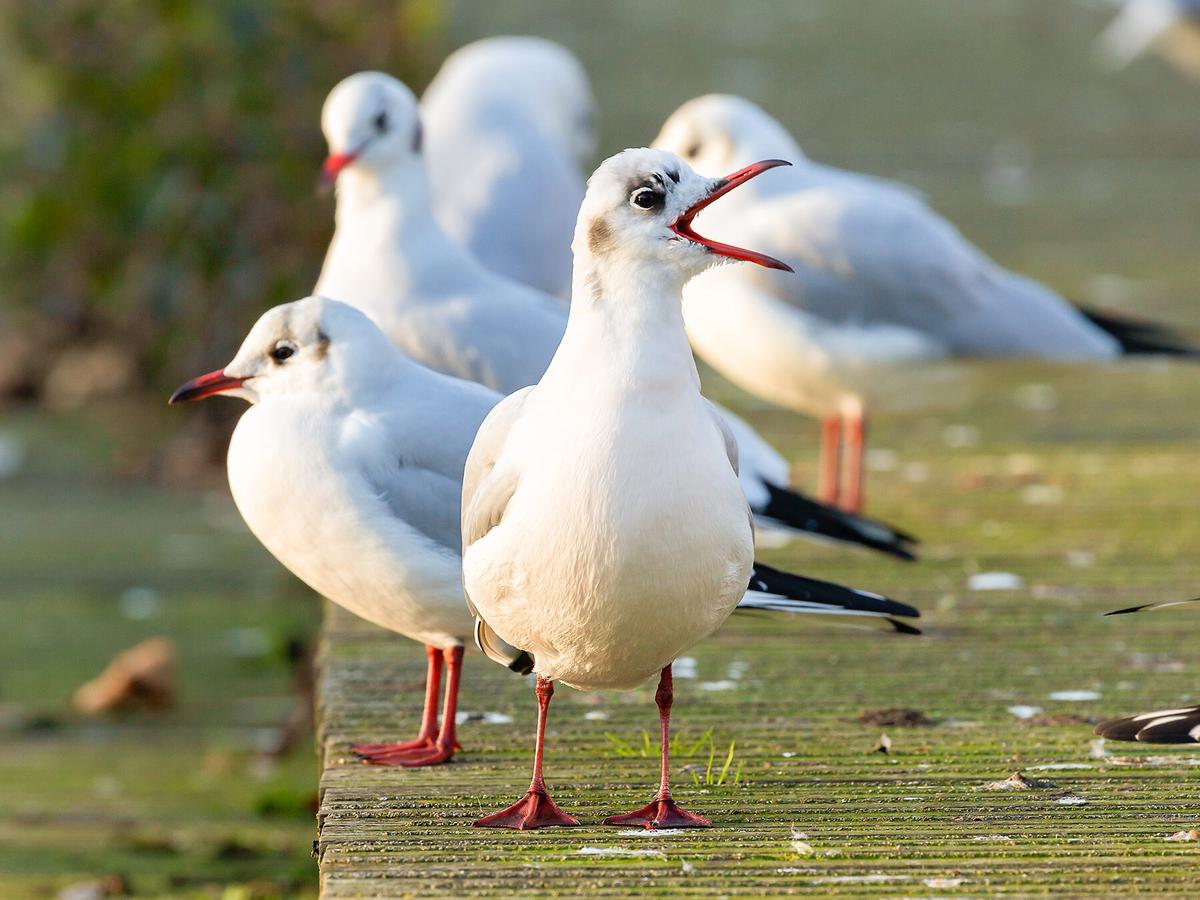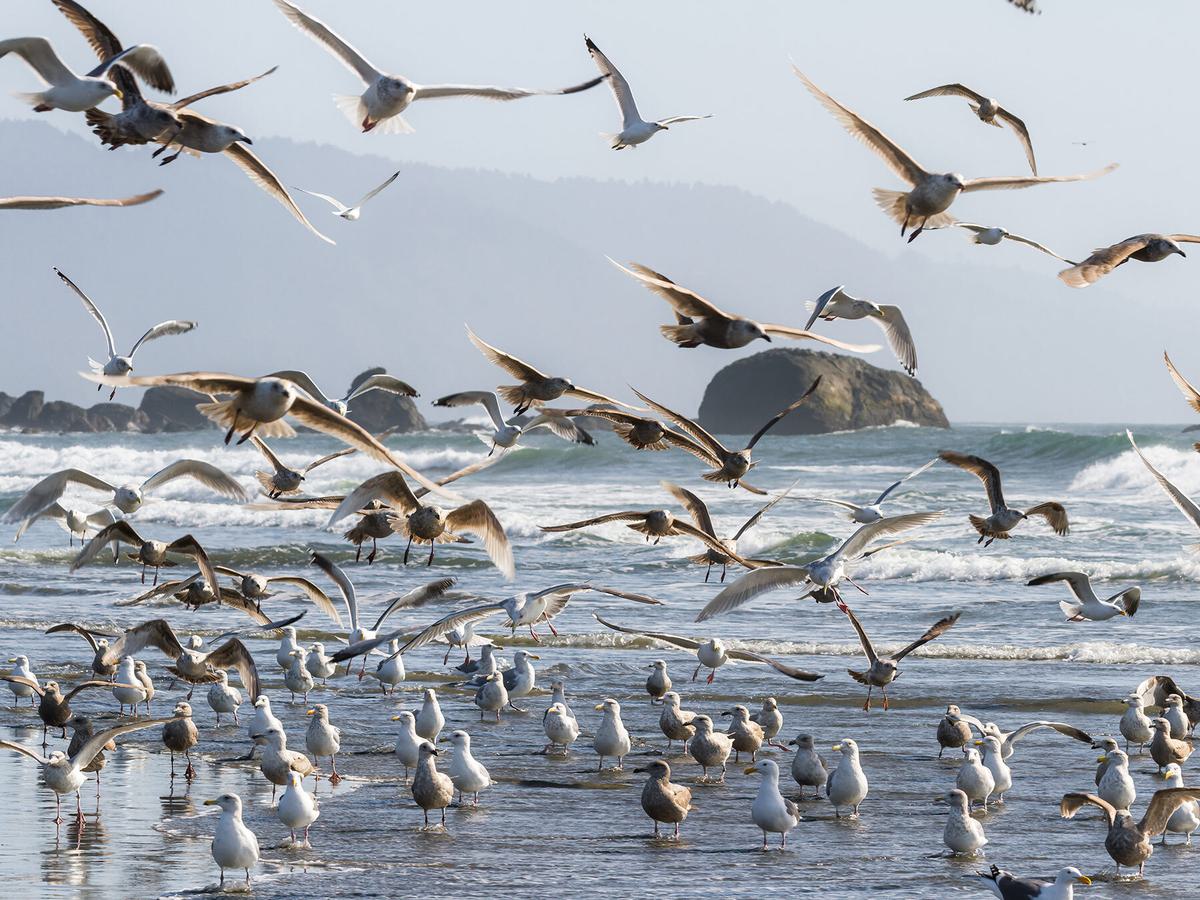Seagulls - which are actually just gulls from the family Laridae - are some of the world's most widespread and successful birds. There are 54 species of gulls, and they inhabit every continent on the planet. A visit to the coast often means exposing oneself to large flocks of ravenous gulls, but what is a group of seagulls called?
The most common collective nouns for groups of seagulls are a colony, flock and scavenging of seagulls. The term colony is used for many sea-faring birds and describes how gulls and other seabirds colonise cliffs, islands and other coastal areas. Gulls are highly gregarious and social, which is why you're more likely to see them in groups rather than alone.
Groups of seagulls are often loud and prominent in coastal areas - they're not scared of humans. If you drop some food at the seaside, a group of gulls will be all over it in seconds - hence why you can call them a scavenging!
Gulls aren't generally well-regarded - most people think they're nasty and aggressive. But, in reality, gulls are exceptionally clever and curious birds that aren't more aggressive than most.
Read on to learn more about the flocking behaviours of this highly gregarious bird!

A small flock of Black-headed Gulls (Chroicocephalus ridibundus)
Other terms for groups of seagulls
- A flotilla of seagulls
- A pack of seagulls
- A screech of seagulls
- A squabble of seagulls
- A swoop of seagulls
A squabble and screech of seagulls are both apt terms. Seagulls have a wide range of loud vocalisations, as well as an instantly recognisable screech as they fly overhead. They also seem to squabble and argue a lot, shouting at each other with a variety of honks, screeches and other loud vocalisations.
Do seagulls flock together in groups?
Gulls are highly gregarious and sociable birds that flock together in their thousands.
Many gull colonies across Europe, Asia, the Americas and the Sub-Antarctic and Sub-Arctic number hundreds of thousands of birds. If you’ve ever visited a coastal town or city, you might have witnessed the full force of a seagull flock yourself!
These are brave, fearless and noisy birds that aren’t afraid to brush shoulders with humans. They might even steal your fish and chips right out of your hands. Gulls are amongst the most social of all birds and have evolved hundreds of complex vocalisations which facilitate advanced levels of communication.

Large colony of gulls
Gulls and study of bird social behaviour
Gull social behaviour actually plays a major role in our understanding of bird behaviour. In the 1940s and 1950s, the pioneering Dutch ornithologist Nikolaas Tinbergen spent many months observing colonies of European Herring gulls both in the Netherlands and the United Kingdom. In 1954, he published The Herring Gull’s World, a seminal study of bird behaviour.
Prior to this, the social behaviour of birds was relatively unresearched. Tinbergen’s study revealed the intricate social behaviours and social structures of gulls - he found that individual gulls and groups of gulls formed strong bonds that seemed to influence their behaviours in a variety of complex ways. For example, gulls have a very strong repertoire of vocalisations and are endearing and protective of each other.
Unfortunately, due to their rather aggressive reputation - though this is often exaggerated - the intelligence of gulls is seldom given the credit it deserves. These exceptionally intelligent birds are amongst the most emphatic communicators of all animals.

A flock of European Herring Gulls (Larus argentatus) on a frozen river
Why do seagulls flock together in large groups?
Seagulls flock during the breeding season and migration. Most species of gulls are strong migrants and some travel many thousands of miles. This is partly why gulls are found on every continent - they’ve colonised the world by flying everywhere!
Gulls also flock together to protect themselves and each other from predators. In addition, Gull colonies have sophisticated alarm systems that help warnings spread through the colony.
Migration
During migration, gulls form flocks of tens to hundreds of birds and typically head south. Gulls from Scandinavia and the Arctic head towards Central and Western Europe. Some North European colonies fly to Africa or the Middle East. Gulls from Canada and Alaska head towards the USA, and some go as far south as Central and South America.
Once they reach their wintering grounds, seagulls tend to form flocks once more. They spend their summer eating, roosting, sleeping and just generally relaxing before flying back to their breeding grounds. Once gulls form breeding colonies, they tend to return to the same spot every year, which also explains why gull colonies are so large.
When seagulls migrate, they sometimes form a ‘V’ or line pattern. They can also be observed seemingly floating along, which means they’ve found a thermal current of rising air to ride on.

Flock of seagulls in flight together over California
Safety in numbers
Like many other birds and animals, gulls also flock together to provide safety in numbers. Studies have found that gulls surround their predators in what some believe is a display of intimidation.
By surrounding their predators rather than fleeing, they make themselves loud and conspicuous, which scares the predator away.
They can even go as far as harassing predators - flocks of gulls are observed harassing eagles and other large raptors, putting them off and sending them into retreat!
Feeding
Last but never least, gulls flock together to feed. It’s not uncommon to see large flocks of gulls pillage farmer’s fields or scavenge human leftovers from coastal areas. When a handful of gulls find a good source of food, more will follow!
When there are multiple species of gulls feeding in one place, they often form large aggregate mixed-species flocks of thousands of birds. Gulls will happily feed alongside other species of gulls.

A large group of Laughing Gulls
When do seagulls flock together in groups?
Most species of seagulls flock together throughout the year. The only time they might spend time on their own is when they wander off when migrating - some gulls can wander some 12,000km throughout winter!
Pairs of gulls will also split off during the breeding season to raise chicks, though they rarely stray too far from the flock. There are exceptions, such as the Great Black-backed gull, which becomes quite solitary during the breeding season.
For the remainder of the year, gulls spend most of their time in groups, flocking together to feed, rest and roost.
In the late breeding season, young gulls often join their own smaller flocks of juveniles which tend to stay near larger adult flocks also containing their parents. Juvenile gulls spend this time watching and learning about hunting and courtship. Young gulls can spend a year tagging along with their parents until they split off to find a mate.

A pair of Great Black-backed gulls fighting over a crab
How many seagulls are in a flock?
Gull colonies can number in the hundreds of thousands. When migrating, flying flocks of seagulls can range into the hundreds. It’s common to see flocks of hundreds of seagulls migrate inland during the winter.
Do seagull families stay together?
Gull parents are highly protective of their chicks and rear them for some 4 to 8 weeks at least. Most gulls are perennially monogamous, which means they mate for life.
There are occasions where gull pairs will break up, such as when they fail to raise a brood for successive breeding seasons. Overall, gulls are dedicated and strongly bonded parents that raise young cooperatively.
After they fledge, juvenile gulls often stay close to their parents, who may join a nearby flock. Some juvenile gulls receive parental care for around a year before they find a mate of their own.
So yes, seagull families do stay together for longer than many other birds.

Least Tern (Sternula antillarum) feeding their chick
Do all seagulls flock together?
Some gulls are more sociable than others. For example, Great Black-backed gulls become quite solitary in the breeding season, where mated pairs split off to nest in more isolated locations.
Not all gulls migrate in large flocks. Some migrate in pairs, or in small groups, stopping off along the way. Vagrant gulls can spend most of the winter wandering about the seas alone - the reasons why some gulls do this is somewhat of a mystery.
What is a pair of seagulls called?
There is no specific name for a pair of gulls. Most gulls mate for life, but some pairs divorce if they cannot raise a successful brood of chicks.
Gulls maintain strong bonds with their mates and are dedicated and attentive parents. Both parents help rear and feed the chicks.

A pair of Kelp Gulls (Larus dominicanus)
What is a group of baby seagulls called?
There’s no specific name for a group of baby seagulls. Young seagulls usually remain under close guard of their parents for around 2 months. So even if you see a baby seagull away from its parents, there’s a good chance that its parents are keeping a close eye!
Once they fledge, gull juveniles tend to tag along with their parents and form their own small juvenile flocks. Many species of gulls take quite a long time to reach maturity - some spend a year or so with their parents before breaking away from the family unit and finding a mate of their own.
